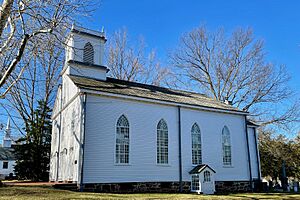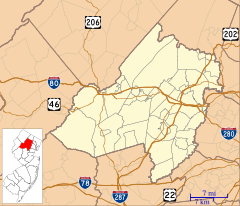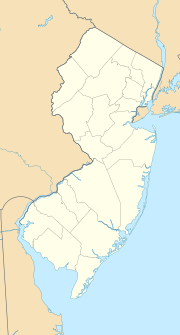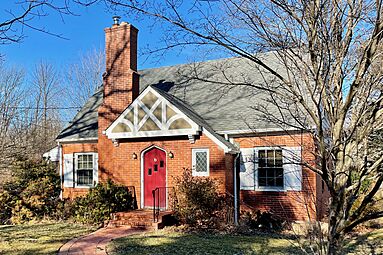New Vernon, New Jersey facts for kids
Quick facts for kids
New Vernon, New Jersey
|
|
|---|---|

First Presbyterian Church of New Vernon
|
|
| Country | |
| State | |
| County | Morris |
| Township | Harding |
| Area | |
| • Total | 3.56 sq mi (9.23 km2) |
| • Land | 3.55 sq mi (9.20 km2) |
| • Water | 0.01 sq mi (0.03 km2) |
| Elevation | 338 ft (103 m) |
| Population
(2020)
|
|
| • Total | 825 |
| • Density | 232.20/sq mi (89.65/km2) |
| Time zone | UTC−05:00 (Eastern (EST)) |
| • Summer (DST) | UTC−04:00 (Eastern (EDT)) |
| ZIP Code |
07976
|
| FIPS code | 34-52020 |
| GNIS feature ID | 878755 |
New Vernon is a small community in Morris County, New Jersey. It's part of Harding Township. This area is known as a census-designated place, which means it's a special area the government tracks for population numbers.
New Vernon shares its space with a part of Green Village. It's also where the main offices for Harding Township are located. The community has its own United States Postal Service ZIP Code, which is 07976. In 2010, about 754 people lived in this ZIP Code area.
Forbes magazine once listed New Vernon's ZIP Code as one of the most "expensive" in the entire country. This means it's a very desirable place to live!
Contents
Discovering New Vernon's Past
New Vernon's story began around 1740. A person named Abraham Canfield moved here and opened a country store. He also had a blacksmith shop and a cider mill. These were important places for people in the area.
The name "New Vernon" first appeared in a newspaper in 1808. This newspaper was printed in Morristown. Later, in 1833, the New Vernon Presbyterian Church was built.
Exploring the New Vernon Historic District
|
New Vernon Historic District
|
|
| Location | Lee's Hill, Village, Mill Brook and Glen Alpin Roads |
|---|---|
| Area | 46 acres (19 ha) |
| Architectural style | Federal, Gothic Revival |
| NRHP reference No. | 82003288 |
| Significant dates | |
| Added to NRHP | July 8, 1982 |
The New Vernon Historic District is a special area that protects old buildings and their history. It covers about 46 acres. You can find it along Lee's Hill, Village, Mill Brook, and Glen Alpin Roads.
This district was added to the National Register of Historic Places in 1982. This means it's recognized for its important architecture and its role in the area's early settlement. There are 24 important buildings in this district.
The First Presbyterian Church of New Vernon, built in 1833, is a key part of the district. It shows off two old building styles: Federal and Gothic Revival. The church also has a manse, which is a house for the minister. This brick house was built in the 1930s in the Tudor architecture style.
Another important building is the Tunis–Ellicks House. This house is now home to the Harding Township Historical Society. It helps people learn about the local history.
Population of New Vernon
According to the 2020 United States census, the population of New Vernon was 825 people.
| Historical population | |||
|---|---|---|---|
| Census | Pop. | %± | |
| 2020 | 825 | — | |
| U.S. Decennial Census 2020 |
|||
Famous People from New Vernon
Many interesting people have lived in or are connected to New Vernon. Here are a few:
- William O. Baker (1915–2005) was a leader at Bell Laboratories, a famous research company.
- Steve Conine (born 1972/73) helped start Wayfair, a big online store.
- Geraldine Rockefeller Dodge (1882–1973) was a very generous person, known as a philanthropist. She loved dogs and helped create the Seeing Eye Foundation, which trains guide dogs.
- Marcellus Hartley Dodge, Sr. (1881–1963) was also a philanthropist. He led the Remington Arms Company and was president of the Y.M.C.A..
- Justin Gimelstob (born 1977) is a professional tennis player.
- Kerry Kittles (born 1974) played basketball for the New Jersey Nets from 1996 to 2004.
- Eric Mangini (born 1971) was the head coach for the New York Jets football team.
- Morgan Pearson (born 1993) is a professional triathlete. He won a silver medal at the 2020 Summer Olympics in the mixed relay event.
- Bo Sullivan (1937-2000) was a politician who led the New Jersey Turnpike Authority.
- Frederick T. van Beuren Jr. (1875–1943) was a doctor and surgeon who managed hospitals and medical schools.








